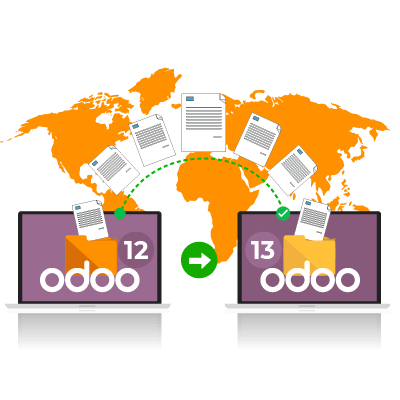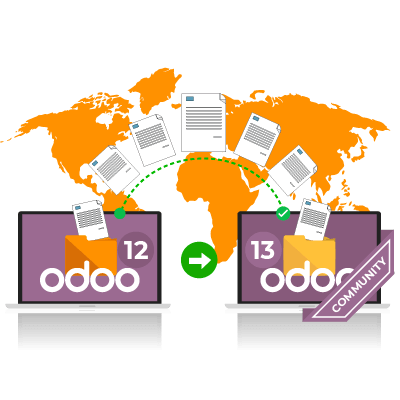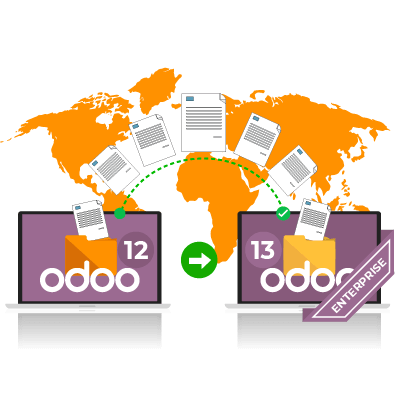Jedes Jahr im Oktober veröffentlicht Odoo eine neue Version seines ERP-Systems. Neben dem Release kompletter, neuer Module veröffentlicht Odoo dabei auch neue Features in den bereits bestehenden Modulen. Dabei greift Odoo nicht nur auf das Know-how der Odoo-Community zurück, sondern lässt ebenfalls das Feedback seiner Kunden einfließen. Mit der regelmäßigen Migration unserer Datenbank auf die nächsthöhere Odoo-Version stellen wir sicher, dass wir stets von den neuesten Modulen und Features profitieren. Doch wie genau läuft die Migration ab? Damit beschäftigen wir uns in unserem heutigen Blog.

Sobald unser Kunde die Odoo-Migration beauftragt hat, starten wir mit der Analysephase. Dabei ist für uns wichtig, welche Odoo-Version unser Kunde nutzt, welche Prozesse in Odoo abgebildet werden und welche Customizations entwickelt wurden beziehungsweise welche Third Party Apps genutzt werden. Gleichzeitig analysieren wir, welche dieser Funktionen in der nächsthöheren Odoo-Version im Standard zur Verfügung gestellt und somit im Altsystem abgelöst werden können.
Diese Phase entscheidet somit auch, welchen Aufwand die Migration mit sich bringt. Je mehr Customizations im Altsystem vorhanden sind, desto höher auch der Aufwand der Migration, da diese Entwicklungen an die nächsthöhere Version angepasst werden müssen.
Im nächsten Schritt erfolgt die Erstellung eines Backups der aktuellen Datenbank. Damit stellen wir sicher, dass unser Kunde während des Migrationsprozesses weiterhin arbeitsfähig ist und wir gleichzeitig eine Datenbank haben, mit der wir den Migrationsprozess vorantreiben können. Haben wir in der Analysephase festgestellt, dass bestimmte Customizations oder Third Party Apps durch neue Funktionen abgelöst werden können, werden diese nun deinstalliert, da sie für den weiteren Prozess nicht mehr relevant sind.
Der weitere Verlauf des Migrationsprozesses ist nun abhängig davon, ob unser Kunde mit Odoo-Community oder Odoo-Enterprise arbeitet. Grundlegend gilt allerdings für beide Modelle, dass wir die eigentliche Migration erst dann starten können, wenn Odoo seinen Prozess für die Kunden freigeschalten hat.
Datenbankmigration von Odoo-Community
Nutzt unser Kunde Odoo-Community, müssen wir also darauf warten, bis die Community die Skripte für die Module migriert hat, die unser Kunde auch benötigt. Anschließend lassen wir die Migrationsskripte der Odoo Community Association (OCA) auf der zu migrierenden Datenbank durchlaufen. Alternativ dazu können diese Migrationsskripte auch durch die Odoo-Partner wie die manaTec GmbH geschrieben werden.
Neben der Datenbankmigration der Community-Version werden anschließend auch die Customizations an die neue Version angepasst.

Datenbankmigration von Odoo-Enterprise
Der wesentliche Unterschied zur Datenbankmigration von Odoo-Community besteht darin, dass die Datenbankmigration der Enterprise-Version durch Odoo selbst durchgeführt wird. Dabei bereiten wir die Datenbank wie eingangs beschrieben vor und senden die Datenbank zu Odoo. Dort wird die Datenbank auf die nächsthöhere Version migriert und an uns zurückgesendet. Parallel dazu arbeiten wir an der Migration der Customizings, um diese auch für die neue Odoo-Version funktionsfähig zu machen.

Im Anschluss an die Datenbankmigration steht uns nun der erste Entwurf der neuen Odoo-Version zur Verfügung und es folgt die Testphase. Dabei testen wir nicht nur die Module, Features und Funktionen innerhalb der kundenspezifischen Prozesse, sondern auch das User Interface und insbesondere die verschiedenen Benutzergruppen. Die Ergebnisse der Tests werden dabei ausführlich von uns dokumentiert.
Stellen wir Fehler innerhalb der migrierten Datenbank fest, folgt eine zweite Iteration der Datenbankmigration analog zu dem bereits beschriebenen Vorgehen. Die Datenbank der Community-Version wird also erneut durch uns und die Datenbank der Enterprise-Version wird erneut durch Odoo migriert. Decken wir Fehler innerhalb der Migration von Customizings auf, werden diese ebenfalls durch uns behoben.
Wurde die Migration der Datenbank und der Customizings fehlerfrei durchlaufen, erfolgt die finale Migration der Live-Datenbank. Im Anschluss daran führen wir nochmals ausführliche Tests durch, die sich an den Erkenntnissen des ersten Testings anlehnen. Im letzten Schritt erfolgt die abschließende Konfiguration und die Übergabe der aktualisierten Datenbank und Customizings an unseren Kunden mittels Import auf den entsprechenden Server. Durch umfangreiche Workshops und Schulungen der Key User unseres Kunden stellen wir im Anschluss an die erfolgreiche Migration sicher, dass unser Kunde die neuen Module beziehungsweise Features optimal nutzt.
Mit der Unterstützung bei der Odoo-Migration sorgen wir dafür, dass unsere Kunden immer in der aktuellen Odoo-Version arbeiten und damit nicht nur von den neuesten Features, sondern auch kleineren Modulanpassungen profitieren. So steigern wir die User Experience durch die Nutzung der neuesten Technologien und bringen damit das Wachstum unserer Kundenunternehmen voran.
Unabhängig davon, ob Community-Version oder Enterprise-Version, wir unterstützen unsere Kunden mit unserem erfahrenen Team von Odoo-Spezialisten während des gesamten Migrationsprozesses von der Planung, über die Durchführung bis hin zum erfolgreichen Abschluss.
Sie wollen Ihre Odoo-Instanz auf die nächsthöhere Version migrieren und benötigen dabei professionelle Unterstützung? Kein Problem! Schauen Sie gleich in unserem Online-Shop vorbei oder kontaktieren Sie uns jetzt und wir stehen Ihnen als zuverlässiger Partner für Ihre Odoo-Migration zur Seite!
Quellen: www.odoo.com
Migration von Odoo-Community und Odoo-Enterprise